Enhancing Team Performance: A Strategic Report on Amoy Food Limited
VerifiedAdded on 2023/06/13
|25
|5997
|145
Report
AI Summary
This report examines the development of successful business teams, focusing on Amoy Food Limited as a case study. It identifies key characteristics of effective teams, such as apparent vision, inspirational leadership, team support, productive communication, and appreciation. The report assesses the importance of team roles using Belbin's model and the manager's role using Blake and Mouton's managerial grid. It also explains the stages of team development using Adair's Action Centred Leadership Model. Furthermore, the report proposes a plan to motivate team members, encourage open communication, resolve conflicts, and monitor and improve team performance over the next six months. This analysis provides valuable insights into building and maintaining high-performing teams within an organization.
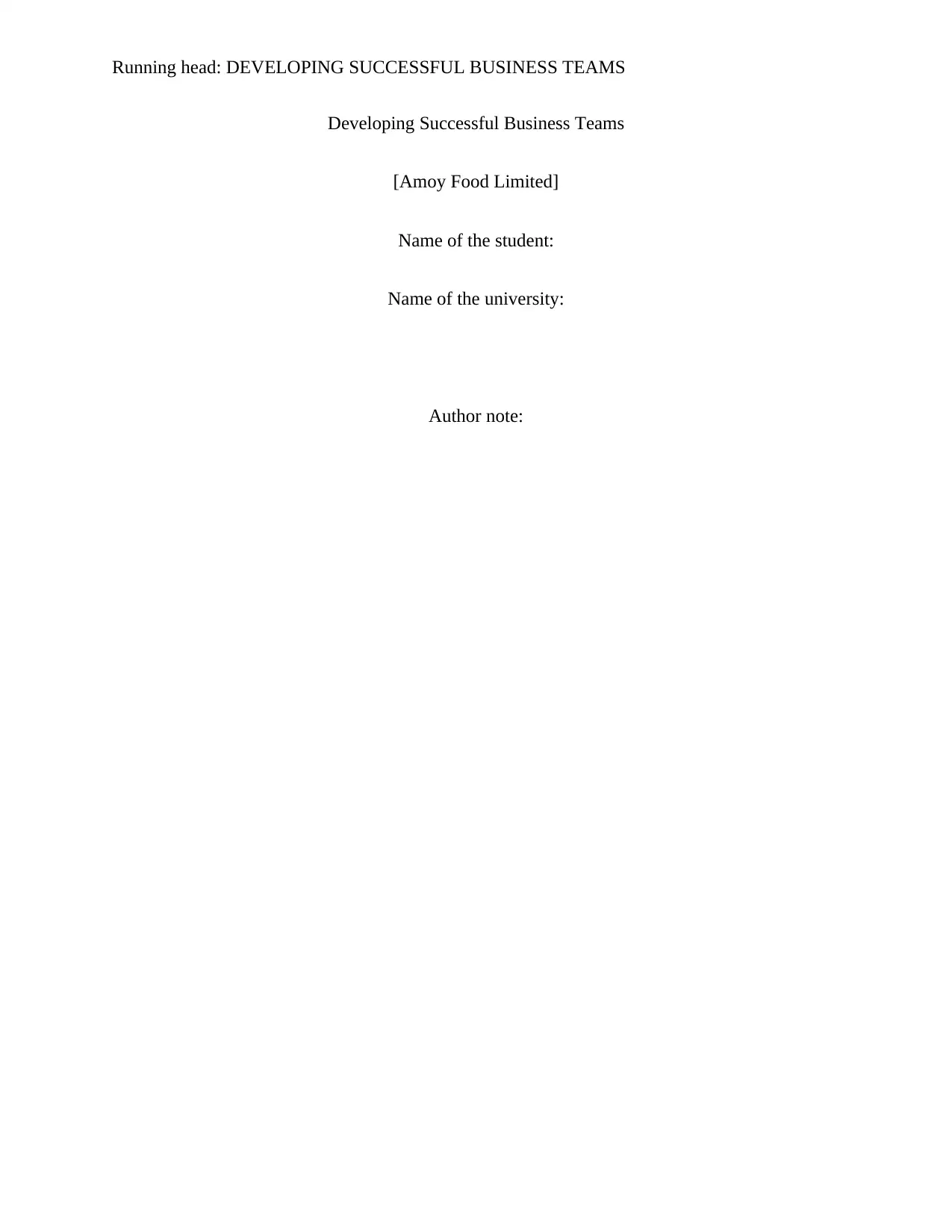
Running head: DEVELOPING SUCCESSFUL BUSINESS TEAMS
Developing Successful Business Teams
[Amoy Food Limited]
Name of the student:
Name of the university:
Author note:
Developing Successful Business Teams
[Amoy Food Limited]
Name of the student:
Name of the university:
Author note:
Paraphrase This Document
Need a fresh take? Get an instant paraphrase of this document with our AI Paraphraser

1DEVELOPING SUCCESSFUL BUSINESS TEAMS
Executive summary
This study is purposefully aimed at highlighting the importance of developing the effective and
successful teams. The formation of a successful team has been described in this study with the
help of various theoretical facts like the Herzberg’s Two-Factor Theory. Such theoretical
backgrounds have shown the ways to construct the effective teams and the managerial skills.
Such initiatives have been adopted in reference to the chosen organisation “Amoy Food Limited”
which manufactures the variety of Sauces and the Frozen Food. The study cites ways to monitor
the team performance in “Amoy” and also the ways to improve the performance.
Executive summary
This study is purposefully aimed at highlighting the importance of developing the effective and
successful teams. The formation of a successful team has been described in this study with the
help of various theoretical facts like the Herzberg’s Two-Factor Theory. Such theoretical
backgrounds have shown the ways to construct the effective teams and the managerial skills.
Such initiatives have been adopted in reference to the chosen organisation “Amoy Food Limited”
which manufactures the variety of Sauces and the Frozen Food. The study cites ways to monitor
the team performance in “Amoy” and also the ways to improve the performance.
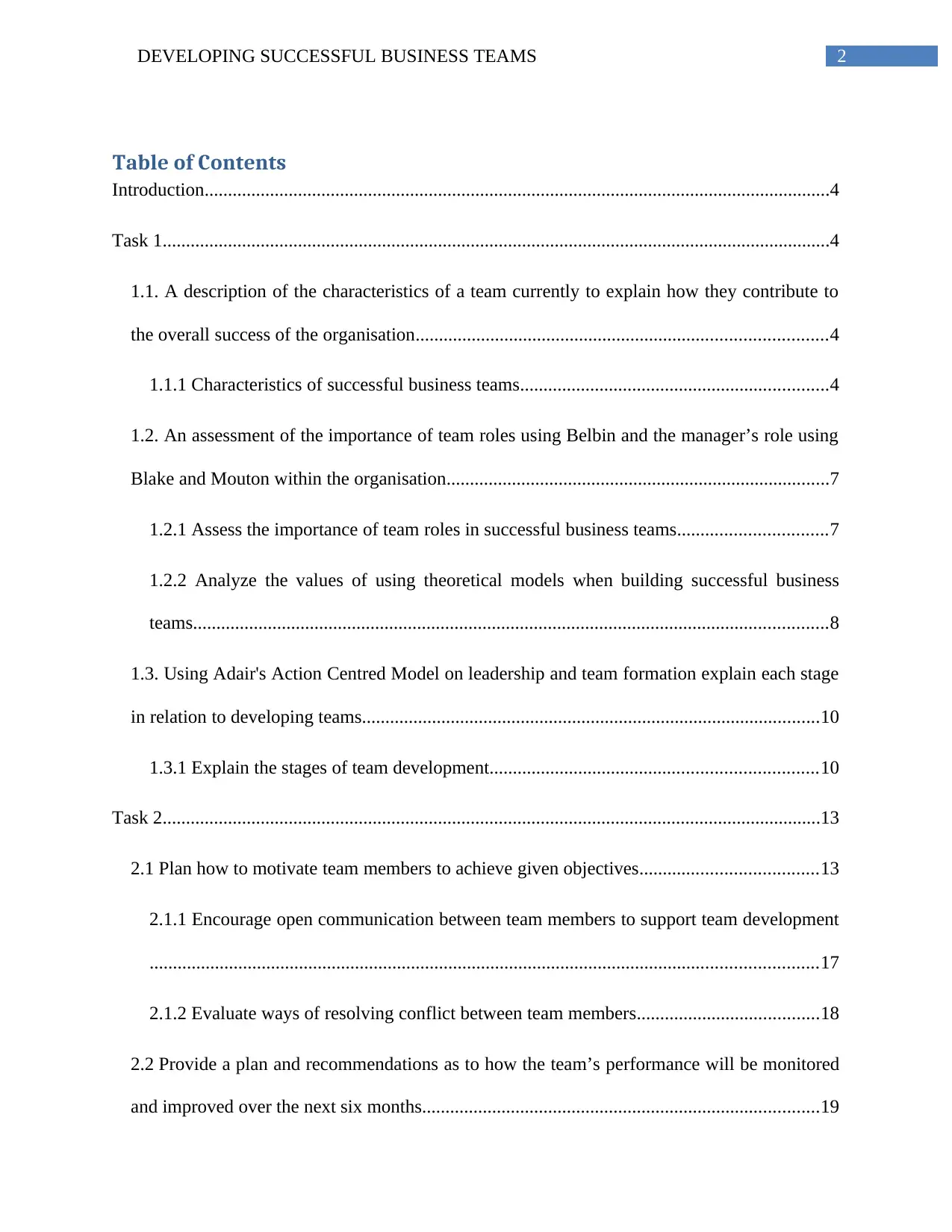
2DEVELOPING SUCCESSFUL BUSINESS TEAMS
Table of Contents
Introduction......................................................................................................................................4
Task 1...............................................................................................................................................4
1.1. A description of the characteristics of a team currently to explain how they contribute to
the overall success of the organisation........................................................................................4
1.1.1 Characteristics of successful business teams..................................................................4
1.2. An assessment of the importance of team roles using Belbin and the manager’s role using
Blake and Mouton within the organisation..................................................................................7
1.2.1 Assess the importance of team roles in successful business teams................................7
1.2.2 Analyze the values of using theoretical models when building successful business
teams........................................................................................................................................8
1.3. Using Adair's Action Centred Model on leadership and team formation explain each stage
in relation to developing teams..................................................................................................10
1.3.1 Explain the stages of team development......................................................................10
Task 2.............................................................................................................................................13
2.1 Plan how to motivate team members to achieve given objectives......................................13
2.1.1 Encourage open communication between team members to support team development
...............................................................................................................................................17
2.1.2 Evaluate ways of resolving conflict between team members.......................................18
2.2 Provide a plan and recommendations as to how the team’s performance will be monitored
and improved over the next six months.....................................................................................19
Table of Contents
Introduction......................................................................................................................................4
Task 1...............................................................................................................................................4
1.1. A description of the characteristics of a team currently to explain how they contribute to
the overall success of the organisation........................................................................................4
1.1.1 Characteristics of successful business teams..................................................................4
1.2. An assessment of the importance of team roles using Belbin and the manager’s role using
Blake and Mouton within the organisation..................................................................................7
1.2.1 Assess the importance of team roles in successful business teams................................7
1.2.2 Analyze the values of using theoretical models when building successful business
teams........................................................................................................................................8
1.3. Using Adair's Action Centred Model on leadership and team formation explain each stage
in relation to developing teams..................................................................................................10
1.3.1 Explain the stages of team development......................................................................10
Task 2.............................................................................................................................................13
2.1 Plan how to motivate team members to achieve given objectives......................................13
2.1.1 Encourage open communication between team members to support team development
...............................................................................................................................................17
2.1.2 Evaluate ways of resolving conflict between team members.......................................18
2.2 Provide a plan and recommendations as to how the team’s performance will be monitored
and improved over the next six months.....................................................................................19
⊘ This is a preview!⊘
Do you want full access?
Subscribe today to unlock all pages.

Trusted by 1+ million students worldwide
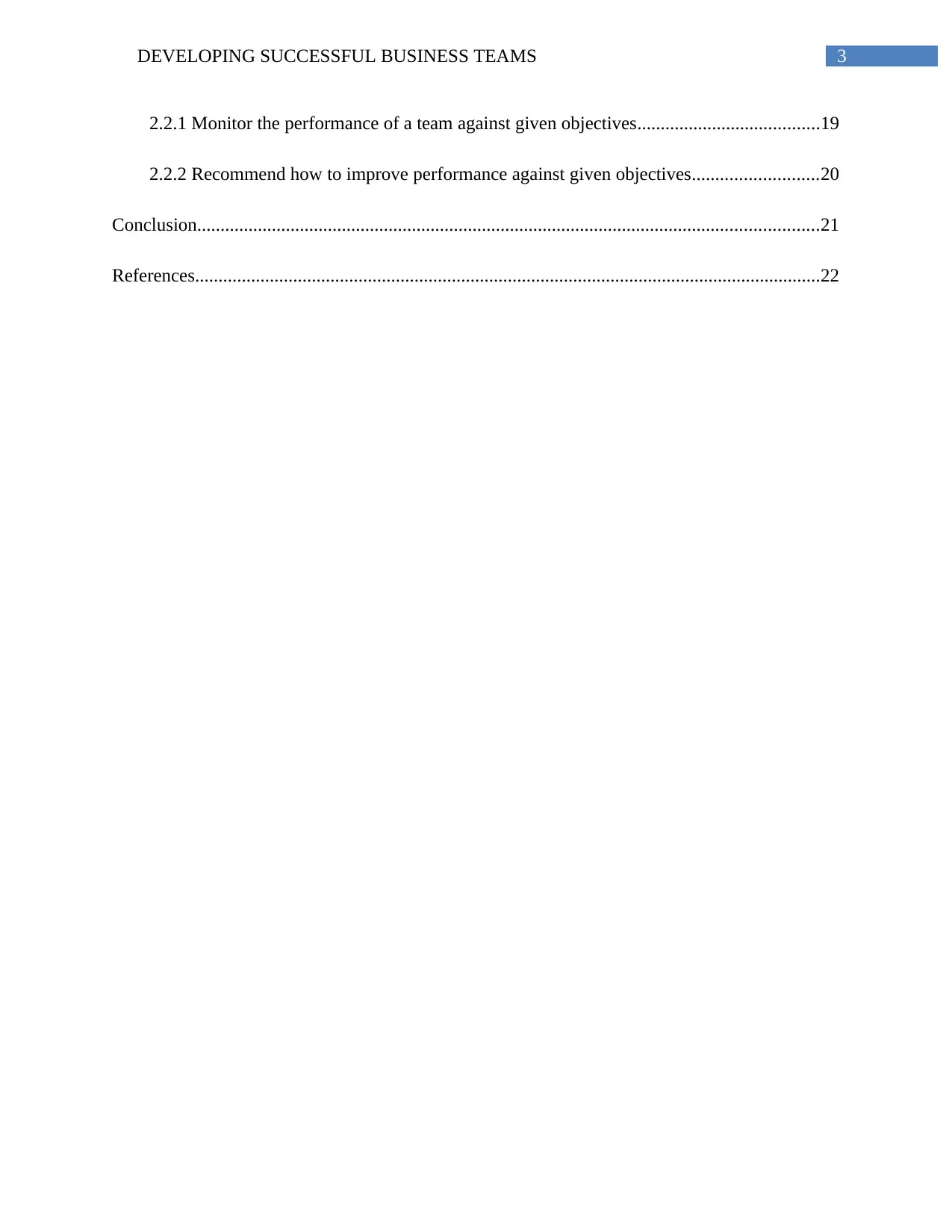
3DEVELOPING SUCCESSFUL BUSINESS TEAMS
2.2.1 Monitor the performance of a team against given objectives.......................................19
2.2.2 Recommend how to improve performance against given objectives...........................20
Conclusion.....................................................................................................................................21
References......................................................................................................................................22
2.2.1 Monitor the performance of a team against given objectives.......................................19
2.2.2 Recommend how to improve performance against given objectives...........................20
Conclusion.....................................................................................................................................21
References......................................................................................................................................22
Paraphrase This Document
Need a fresh take? Get an instant paraphrase of this document with our AI Paraphraser
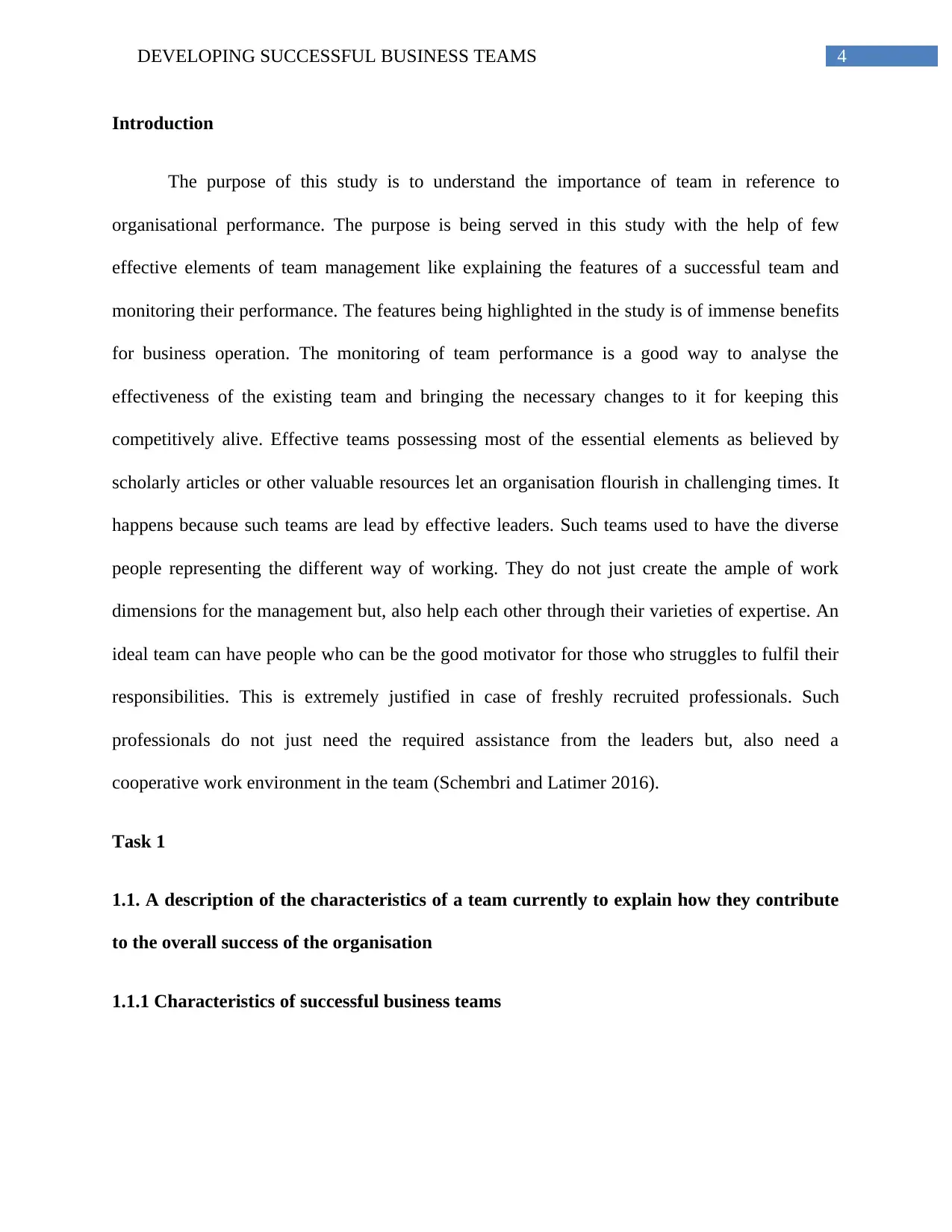
4DEVELOPING SUCCESSFUL BUSINESS TEAMS
Introduction
The purpose of this study is to understand the importance of team in reference to
organisational performance. The purpose is being served in this study with the help of few
effective elements of team management like explaining the features of a successful team and
monitoring their performance. The features being highlighted in the study is of immense benefits
for business operation. The monitoring of team performance is a good way to analyse the
effectiveness of the existing team and bringing the necessary changes to it for keeping this
competitively alive. Effective teams possessing most of the essential elements as believed by
scholarly articles or other valuable resources let an organisation flourish in challenging times. It
happens because such teams are lead by effective leaders. Such teams used to have the diverse
people representing the different way of working. They do not just create the ample of work
dimensions for the management but, also help each other through their varieties of expertise. An
ideal team can have people who can be the good motivator for those who struggles to fulfil their
responsibilities. This is extremely justified in case of freshly recruited professionals. Such
professionals do not just need the required assistance from the leaders but, also need a
cooperative work environment in the team (Schembri and Latimer 2016).
Task 1
1.1. A description of the characteristics of a team currently to explain how they contribute
to the overall success of the organisation
1.1.1 Characteristics of successful business teams
Introduction
The purpose of this study is to understand the importance of team in reference to
organisational performance. The purpose is being served in this study with the help of few
effective elements of team management like explaining the features of a successful team and
monitoring their performance. The features being highlighted in the study is of immense benefits
for business operation. The monitoring of team performance is a good way to analyse the
effectiveness of the existing team and bringing the necessary changes to it for keeping this
competitively alive. Effective teams possessing most of the essential elements as believed by
scholarly articles or other valuable resources let an organisation flourish in challenging times. It
happens because such teams are lead by effective leaders. Such teams used to have the diverse
people representing the different way of working. They do not just create the ample of work
dimensions for the management but, also help each other through their varieties of expertise. An
ideal team can have people who can be the good motivator for those who struggles to fulfil their
responsibilities. This is extremely justified in case of freshly recruited professionals. Such
professionals do not just need the required assistance from the leaders but, also need a
cooperative work environment in the team (Schembri and Latimer 2016).
Task 1
1.1. A description of the characteristics of a team currently to explain how they contribute
to the overall success of the organisation
1.1.1 Characteristics of successful business teams
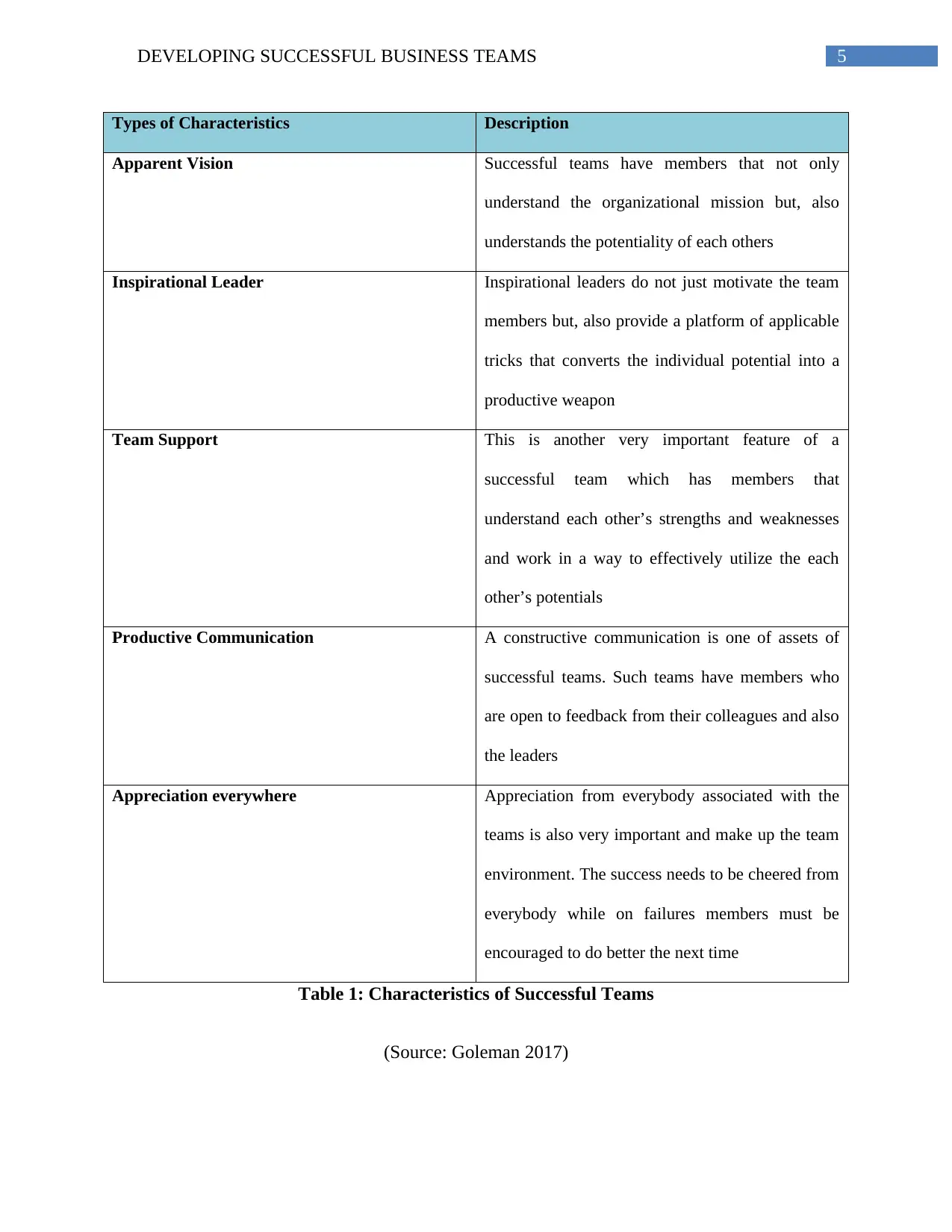
5DEVELOPING SUCCESSFUL BUSINESS TEAMS
Types of Characteristics Description
Apparent Vision Successful teams have members that not only
understand the organizational mission but, also
understands the potentiality of each others
Inspirational Leader Inspirational leaders do not just motivate the team
members but, also provide a platform of applicable
tricks that converts the individual potential into a
productive weapon
Team Support This is another very important feature of a
successful team which has members that
understand each other’s strengths and weaknesses
and work in a way to effectively utilize the each
other’s potentials
Productive Communication A constructive communication is one of assets of
successful teams. Such teams have members who
are open to feedback from their colleagues and also
the leaders
Appreciation everywhere Appreciation from everybody associated with the
teams is also very important and make up the team
environment. The success needs to be cheered from
everybody while on failures members must be
encouraged to do better the next time
Table 1: Characteristics of Successful Teams
(Source: Goleman 2017)
Types of Characteristics Description
Apparent Vision Successful teams have members that not only
understand the organizational mission but, also
understands the potentiality of each others
Inspirational Leader Inspirational leaders do not just motivate the team
members but, also provide a platform of applicable
tricks that converts the individual potential into a
productive weapon
Team Support This is another very important feature of a
successful team which has members that
understand each other’s strengths and weaknesses
and work in a way to effectively utilize the each
other’s potentials
Productive Communication A constructive communication is one of assets of
successful teams. Such teams have members who
are open to feedback from their colleagues and also
the leaders
Appreciation everywhere Appreciation from everybody associated with the
teams is also very important and make up the team
environment. The success needs to be cheered from
everybody while on failures members must be
encouraged to do better the next time
Table 1: Characteristics of Successful Teams
(Source: Goleman 2017)
⊘ This is a preview!⊘
Do you want full access?
Subscribe today to unlock all pages.

Trusted by 1+ million students worldwide

6DEVELOPING SUCCESSFUL BUSINESS TEAMS
“Amoy Food Limited” has been able to survive for so many years since its inception in 1908
(Amoy.com 2018). The company was acknowledged as the CSR Advocate in the CSR Index
produced by ‘HKQAA – HSBC’ (Amoy.com 2018). The recognition supports the stated fact that
the company has managed to survive ever since it was being introduced in the food industry in
Hong Kong (Amoy.com 2018). They have been able to survive with their reliable & quality
products and desires for Exploring the New Markets. The quality service and the expanding
business network could have been possible due to the effective organizational leadership and the
teamwork. The leadership style in the company is human-oriented which is accomplished by
fulfilling a variety of defined set of responsibilities such as promoting the social responsibility
(Amoy.com 2018).
The leadership style identified in “Amoy” is successfully engaged in promoting the
teams that must exhibit the following features (Amoy.com 2018):
Trust and Respect: In “Amoy”, team members are infused with values for trust and
respect that means every contribution is respected. It also means individuals have trust on each
other’s potentiality and are aware of ways to utilize the varied potentials. The respect that
employees have for each other helps to maintain a harmonious relation between the team
members. The trust within the team indicates that team members are aware of each other’s
strengths and weaknesses which are necessary to plan a proper utilisation of individuals.
Constructive Communication: The teams are engaged with constructive communication
which does not only deepen the trust between each other but, also make them open for feedback
from colleagues and the leaders. In this way, they are not just entertaining the feedback system
but, they actually support the knowledge management within the organisation.
“Amoy Food Limited” has been able to survive for so many years since its inception in 1908
(Amoy.com 2018). The company was acknowledged as the CSR Advocate in the CSR Index
produced by ‘HKQAA – HSBC’ (Amoy.com 2018). The recognition supports the stated fact that
the company has managed to survive ever since it was being introduced in the food industry in
Hong Kong (Amoy.com 2018). They have been able to survive with their reliable & quality
products and desires for Exploring the New Markets. The quality service and the expanding
business network could have been possible due to the effective organizational leadership and the
teamwork. The leadership style in the company is human-oriented which is accomplished by
fulfilling a variety of defined set of responsibilities such as promoting the social responsibility
(Amoy.com 2018).
The leadership style identified in “Amoy” is successfully engaged in promoting the
teams that must exhibit the following features (Amoy.com 2018):
Trust and Respect: In “Amoy”, team members are infused with values for trust and
respect that means every contribution is respected. It also means individuals have trust on each
other’s potentiality and are aware of ways to utilize the varied potentials. The respect that
employees have for each other helps to maintain a harmonious relation between the team
members. The trust within the team indicates that team members are aware of each other’s
strengths and weaknesses which are necessary to plan a proper utilisation of individuals.
Constructive Communication: The teams are engaged with constructive communication
which does not only deepen the trust between each other but, also make them open for feedback
from colleagues and the leaders. In this way, they are not just entertaining the feedback system
but, they actually support the knowledge management within the organisation.
Paraphrase This Document
Need a fresh take? Get an instant paraphrase of this document with our AI Paraphraser

7DEVELOPING SUCCESSFUL BUSINESS TEAMS
Creativity: Team members are creative and believe to utilise their skills to explore their
best output. Such practices are a boost to creative works which are the basis of organizational
innovation.
1.2. An assessment of the importance of team roles using Belbin and the manager’s role
using Blake and Mouton within the organisation
1.2.1 Assess the importance of team roles in successful business teams
The importance of ‘Team Roles’ can be effectively assessed with the help of Belbin’s
Team Roles. Belbin’s Team Roles establishes the importance of ‘Team Roles’ in the following
way (Meslec and Curşeu 2015):
Action Oriented Roles
Shaper: It is the one that actually shapes the team performance. This can be the effective
leaders and also the productive teams at the organizational level. Leaders encourage the teams to
have positive attitudes for the required action. Team members encourage each other within the
team.
Implementer: It is the leaders who put the ideas into action. Team members support such
ideas by working to their potentials.
Complete Finisher: This depends a lot on the managerial skills of the leaders. Managers
are responsible to reduce the barriers that delay the outcome of an action. Barriers can be of
variety of types that also includes the intercultural conflicts, racism, communication, and the
ineffective leadership (Head and Alford 2015). Such barriers require a strong repulsive action
from the leaders, so that, a timely completion of the project is ensured (Head and Alford 2015).
Creativity: Team members are creative and believe to utilise their skills to explore their
best output. Such practices are a boost to creative works which are the basis of organizational
innovation.
1.2. An assessment of the importance of team roles using Belbin and the manager’s role
using Blake and Mouton within the organisation
1.2.1 Assess the importance of team roles in successful business teams
The importance of ‘Team Roles’ can be effectively assessed with the help of Belbin’s
Team Roles. Belbin’s Team Roles establishes the importance of ‘Team Roles’ in the following
way (Meslec and Curşeu 2015):
Action Oriented Roles
Shaper: It is the one that actually shapes the team performance. This can be the effective
leaders and also the productive teams at the organizational level. Leaders encourage the teams to
have positive attitudes for the required action. Team members encourage each other within the
team.
Implementer: It is the leaders who put the ideas into action. Team members support such
ideas by working to their potentials.
Complete Finisher: This depends a lot on the managerial skills of the leaders. Managers
are responsible to reduce the barriers that delay the outcome of an action. Barriers can be of
variety of types that also includes the intercultural conflicts, racism, communication, and the
ineffective leadership (Head and Alford 2015). Such barriers require a strong repulsive action
from the leaders, so that, a timely completion of the project is ensured (Head and Alford 2015).
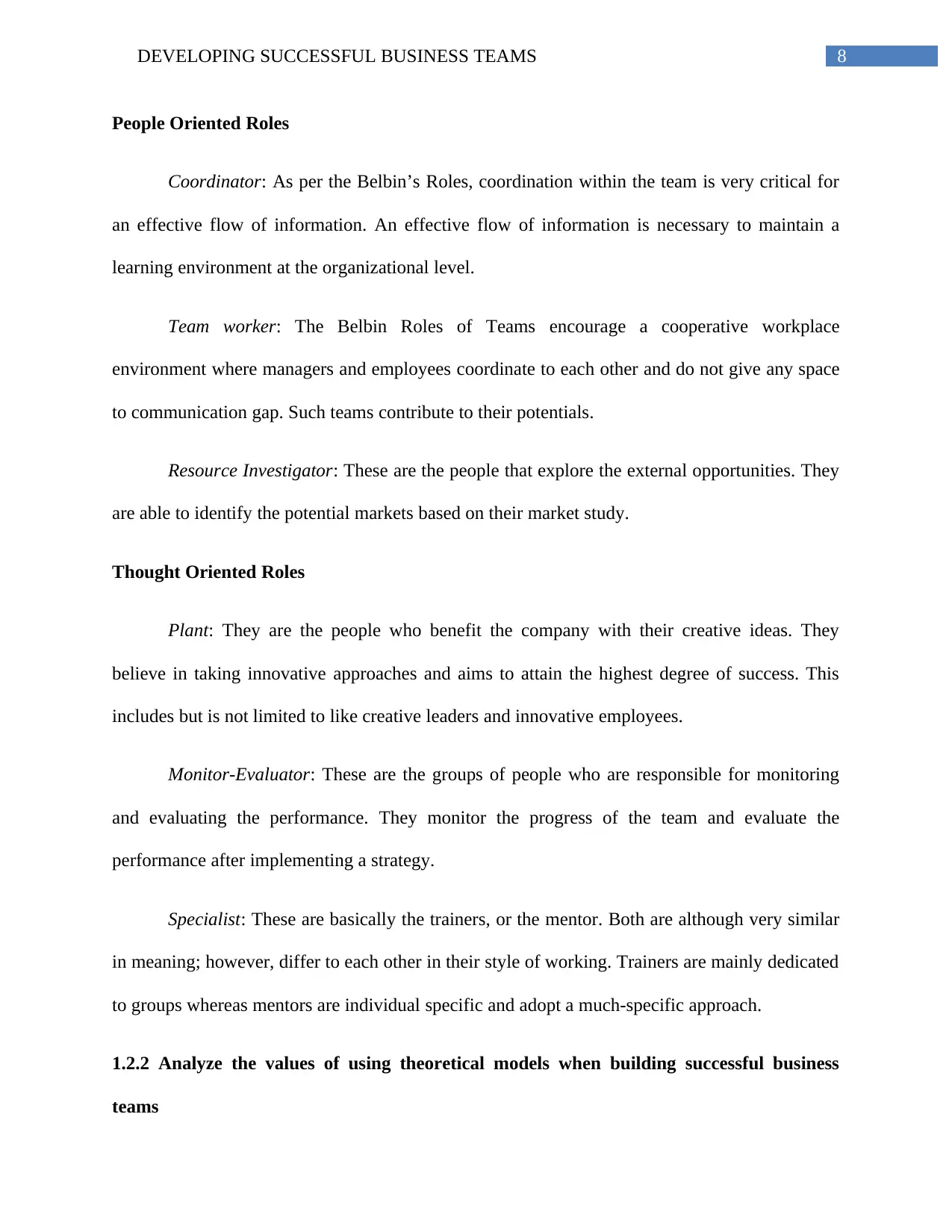
8DEVELOPING SUCCESSFUL BUSINESS TEAMS
People Oriented Roles
Coordinator: As per the Belbin’s Roles, coordination within the team is very critical for
an effective flow of information. An effective flow of information is necessary to maintain a
learning environment at the organizational level.
Team worker: The Belbin Roles of Teams encourage a cooperative workplace
environment where managers and employees coordinate to each other and do not give any space
to communication gap. Such teams contribute to their potentials.
Resource Investigator: These are the people that explore the external opportunities. They
are able to identify the potential markets based on their market study.
Thought Oriented Roles
Plant: They are the people who benefit the company with their creative ideas. They
believe in taking innovative approaches and aims to attain the highest degree of success. This
includes but is not limited to like creative leaders and innovative employees.
Monitor-Evaluator: These are the groups of people who are responsible for monitoring
and evaluating the performance. They monitor the progress of the team and evaluate the
performance after implementing a strategy.
Specialist: These are basically the trainers, or the mentor. Both are although very similar
in meaning; however, differ to each other in their style of working. Trainers are mainly dedicated
to groups whereas mentors are individual specific and adopt a much-specific approach.
1.2.2 Analyze the values of using theoretical models when building successful business
teams
People Oriented Roles
Coordinator: As per the Belbin’s Roles, coordination within the team is very critical for
an effective flow of information. An effective flow of information is necessary to maintain a
learning environment at the organizational level.
Team worker: The Belbin Roles of Teams encourage a cooperative workplace
environment where managers and employees coordinate to each other and do not give any space
to communication gap. Such teams contribute to their potentials.
Resource Investigator: These are the people that explore the external opportunities. They
are able to identify the potential markets based on their market study.
Thought Oriented Roles
Plant: They are the people who benefit the company with their creative ideas. They
believe in taking innovative approaches and aims to attain the highest degree of success. This
includes but is not limited to like creative leaders and innovative employees.
Monitor-Evaluator: These are the groups of people who are responsible for monitoring
and evaluating the performance. They monitor the progress of the team and evaluate the
performance after implementing a strategy.
Specialist: These are basically the trainers, or the mentor. Both are although very similar
in meaning; however, differ to each other in their style of working. Trainers are mainly dedicated
to groups whereas mentors are individual specific and adopt a much-specific approach.
1.2.2 Analyze the values of using theoretical models when building successful business
teams
⊘ This is a preview!⊘
Do you want full access?
Subscribe today to unlock all pages.

Trusted by 1+ million students worldwide

9DEVELOPING SUCCESSFUL BUSINESS TEAMS
Blake and Mouton had developed a model in 1964 which is popularly known as the
“managerial grid model”. The model has covered a few of the leadership styles and had
represented those in the form of a grid with the help of two axis namely x-axis and y-axis. Each
axis ranges from 1 to 9 where 1 is represented as ‘low’ and ‘9’ as ‘high’. The leadership styles
calculated in such a way is as the follows (Thomas 2016):
The indifferent Style (1, 1): evade and elude.
Such managers are less innovative due to their low concerns for both people and
production. They have the tendency to protect the seniors. In other words, they do not like things
which can produce troubles for them.
The Accommodating Style (1, 9): yield and comply.
Such leaders have high concerns for people but, have very less for production. In other
words, they are protective to people which many a times can lead to unproductive results.
The status Quo Style (5, 5): balance and compromise.
Such leaders try to maintain a balance between people and production; however, they
sometime give away a bit of concerns that is critical for productivity and also for the betterment
of people.
The Dictatorial Style (9, 1): control and dominate.
These managers are much in support of productive results. In doing so, such leaders do
not even think of people and their rights. To such leaders employee’s needs are less important.
The Opportunistic Style: exploit and manipulate.
Blake and Mouton had developed a model in 1964 which is popularly known as the
“managerial grid model”. The model has covered a few of the leadership styles and had
represented those in the form of a grid with the help of two axis namely x-axis and y-axis. Each
axis ranges from 1 to 9 where 1 is represented as ‘low’ and ‘9’ as ‘high’. The leadership styles
calculated in such a way is as the follows (Thomas 2016):
The indifferent Style (1, 1): evade and elude.
Such managers are less innovative due to their low concerns for both people and
production. They have the tendency to protect the seniors. In other words, they do not like things
which can produce troubles for them.
The Accommodating Style (1, 9): yield and comply.
Such leaders have high concerns for people but, have very less for production. In other
words, they are protective to people which many a times can lead to unproductive results.
The status Quo Style (5, 5): balance and compromise.
Such leaders try to maintain a balance between people and production; however, they
sometime give away a bit of concerns that is critical for productivity and also for the betterment
of people.
The Dictatorial Style (9, 1): control and dominate.
These managers are much in support of productive results. In doing so, such leaders do
not even think of people and their rights. To such leaders employee’s needs are less important.
The Opportunistic Style: exploit and manipulate.
Paraphrase This Document
Need a fresh take? Get an instant paraphrase of this document with our AI Paraphraser

10DEVELOPING SUCCESSFUL BUSINESS TEAMS
Such leaders are very opportunistic and are in continued hunts for opportunities. They are
not fixed with any single leadership style described in the managerial grid model.
The Sound Style (9, 9): contribute and commit.
These are fundamentally the ideal leaders who have equal concerns for people and
production. They support teamwork which is necessary for a committed approach to a project.
Employees are treated as the constructive parts of the organization.
The Paternalistic Style (1, 9) and (9, 1): prescribe and guide.
Managers with this leadership styles appreciate and praise the works but, have high
disregards for challenges.
1.3. Using Adair's Action Centred Model on leadership and team formation explain each
stage in relation to developing teams
1.3.1 Explain the stages of team development
The Action Centred Leadership Model by John Adair highlighted the leaders as
possessing the 8 different leadership functions which are helpful in developing teams. Those
functions are as listed below (Ullah 2017):
Definition of Task: Leaders can facilitate the set of tasks by setting distinct objectives
with the help of SMART goals. SMART goals can also be defined as realistic goals. Leaders
construct such goals after analyzing its feasibility with the dedicated teams and the other
organizational resources. Every individual is aligned to SMART goals and they are encouraged
by leaders to work accordingly.
Such leaders are very opportunistic and are in continued hunts for opportunities. They are
not fixed with any single leadership style described in the managerial grid model.
The Sound Style (9, 9): contribute and commit.
These are fundamentally the ideal leaders who have equal concerns for people and
production. They support teamwork which is necessary for a committed approach to a project.
Employees are treated as the constructive parts of the organization.
The Paternalistic Style (1, 9) and (9, 1): prescribe and guide.
Managers with this leadership styles appreciate and praise the works but, have high
disregards for challenges.
1.3. Using Adair's Action Centred Model on leadership and team formation explain each
stage in relation to developing teams
1.3.1 Explain the stages of team development
The Action Centred Leadership Model by John Adair highlighted the leaders as
possessing the 8 different leadership functions which are helpful in developing teams. Those
functions are as listed below (Ullah 2017):
Definition of Task: Leaders can facilitate the set of tasks by setting distinct objectives
with the help of SMART goals. SMART goals can also be defined as realistic goals. Leaders
construct such goals after analyzing its feasibility with the dedicated teams and the other
organizational resources. Every individual is aligned to SMART goals and they are encouraged
by leaders to work accordingly.
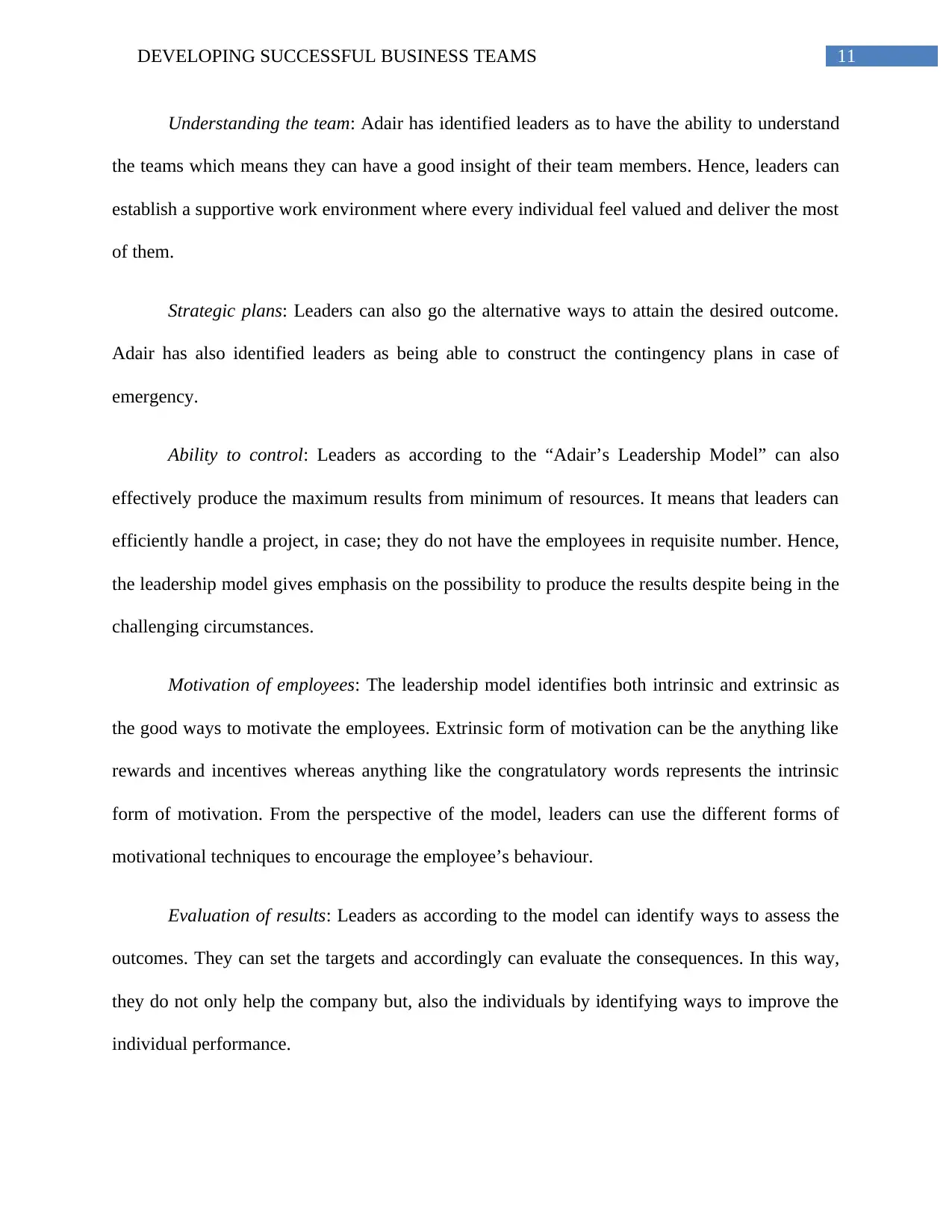
11DEVELOPING SUCCESSFUL BUSINESS TEAMS
Understanding the team: Adair has identified leaders as to have the ability to understand
the teams which means they can have a good insight of their team members. Hence, leaders can
establish a supportive work environment where every individual feel valued and deliver the most
of them.
Strategic plans: Leaders can also go the alternative ways to attain the desired outcome.
Adair has also identified leaders as being able to construct the contingency plans in case of
emergency.
Ability to control: Leaders as according to the “Adair’s Leadership Model” can also
effectively produce the maximum results from minimum of resources. It means that leaders can
efficiently handle a project, in case; they do not have the employees in requisite number. Hence,
the leadership model gives emphasis on the possibility to produce the results despite being in the
challenging circumstances.
Motivation of employees: The leadership model identifies both intrinsic and extrinsic as
the good ways to motivate the employees. Extrinsic form of motivation can be the anything like
rewards and incentives whereas anything like the congratulatory words represents the intrinsic
form of motivation. From the perspective of the model, leaders can use the different forms of
motivational techniques to encourage the employee’s behaviour.
Evaluation of results: Leaders as according to the model can identify ways to assess the
outcomes. They can set the targets and accordingly can evaluate the consequences. In this way,
they do not only help the company but, also the individuals by identifying ways to improve the
individual performance.
Understanding the team: Adair has identified leaders as to have the ability to understand
the teams which means they can have a good insight of their team members. Hence, leaders can
establish a supportive work environment where every individual feel valued and deliver the most
of them.
Strategic plans: Leaders can also go the alternative ways to attain the desired outcome.
Adair has also identified leaders as being able to construct the contingency plans in case of
emergency.
Ability to control: Leaders as according to the “Adair’s Leadership Model” can also
effectively produce the maximum results from minimum of resources. It means that leaders can
efficiently handle a project, in case; they do not have the employees in requisite number. Hence,
the leadership model gives emphasis on the possibility to produce the results despite being in the
challenging circumstances.
Motivation of employees: The leadership model identifies both intrinsic and extrinsic as
the good ways to motivate the employees. Extrinsic form of motivation can be the anything like
rewards and incentives whereas anything like the congratulatory words represents the intrinsic
form of motivation. From the perspective of the model, leaders can use the different forms of
motivational techniques to encourage the employee’s behaviour.
Evaluation of results: Leaders as according to the model can identify ways to assess the
outcomes. They can set the targets and accordingly can evaluate the consequences. In this way,
they do not only help the company but, also the individuals by identifying ways to improve the
individual performance.
⊘ This is a preview!⊘
Do you want full access?
Subscribe today to unlock all pages.

Trusted by 1+ million students worldwide
1 out of 25
Related Documents
Your All-in-One AI-Powered Toolkit for Academic Success.
+13062052269
info@desklib.com
Available 24*7 on WhatsApp / Email
![[object Object]](/_next/static/media/star-bottom.7253800d.svg)
Unlock your academic potential
Copyright © 2020–2025 A2Z Services. All Rights Reserved. Developed and managed by ZUCOL.




